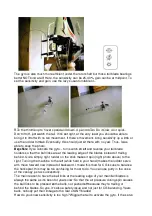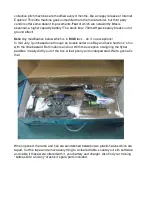
Otherwise, it might swing on you and these gyros really are just “tail dampeners” in my
opinion. Hopefully, you've added the tailskid I suggested in the prior chapter.
Initial hovering and trimming
In “no wind” conditions and on linoleum, you want to trim the swashplate so that it
doesn't walk left/right or fore/aft to the point of liftoff. With a breeze, you'll add a few
ticks forward trim. At liftoff point, you want the rudder trimmed so that little or no rudder
input is required to hold it. I have found this difficult to do with this tail system and gyro.
Every damn tail strike shifts the trim!
If these trims are achieved, you raise the machine to eye level and balance the “broom”
on your right hand while keeping the tail at you. You are effectively balancing 2 brooms
if you think about it. Keeping it near the ground is just making it more difficult, at least 3'
would be okay for this size of machine. There is nothing from stopping your adjustment
of the gyro, I would try sensitivty a bit higher if needed.
Advice for learning:
Fly the thing with full thumb & forefinger on the sticks using either a
Tx tray or sit down in a light folding chair. Thumb flying is difficult and this does not
have the inertia of a gas machine with wooden blades either. Don't fly thumbs! Also, it
will help to put the canopy on the front and “fly the nose”! Watch the nose or reference
the front of the machine instead of the tail to keep yourself oriented.
This happens to all heli pilots: Losing the tail. It's not instinct to do this, but the best
thing to do is get altitude quick by hitting the throttle and get it over 6'. Lower the throttle
and regain tail orientation. In a worst case scenario, hit forward cyclic and enter forward
flight, you turn with left/right swashplate and a little bit of added rudder in the same
direction.
The important thing to remember here is that if it turns nosein at you, the swashplate
stick is all reversed and you are going to crash it within seconds... unless you are
incredibly talented. Generally, you just want to give it power to gain height and in turn
TIME to reorient.
If you're able to hover it controllably by the first week, you're doing pretty well. Try
walking it under control forward/back, left/right. Try different altitudes. With plenty of
space around you, try a slow forward flight around yourself. Do this by just giving it little
forward stick inputs and no left/right. You steer with the rudder, just tapping it as you
walk it all around yourself about 10' out from you. You keep your whole body/stance
oriented with the nose of the machine and the heli is to your right or left facing forward.
Turn with the machine as you fly a large slow/sloppy circle around yourself. Let it be
sloppy but maintain tail orientation! Turn the tail in toward you and set down.
You might want to try landing and lifting off targets on the ground. Like lime X's or some
marker. Also, I did mention a simple training setup with tomato plant stakes and foam
balls. Before you enter forward flight at an altitude though, I would like to see you able
to land and take off from a good sized table. A picnic table, for instance.
This machine will be hard to learn because there's no dihedral in the head:
The DF35 has no upswept blades, the main bearing shaft is a solid rod from one blade
Summary of Contents for Dragonfly 4
Page 4: ...3 RTV silicone sealant VERY important 3...
Page 72: ...The flybar stabilizer yoke must not bind like this...
Page 75: ...Lock it s position with Loctite Sight them at 0 to each other and center seesaw add some...
Page 86: ...Pull the Jesus Pin 035 If you ever lose it a paper clip works fine...
Page 87: ...Unclip the lower ball links of your onion rings Pull the entire head straight up...






























